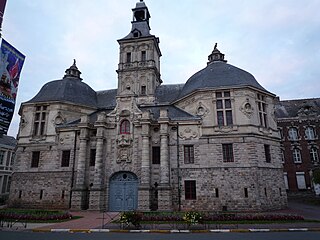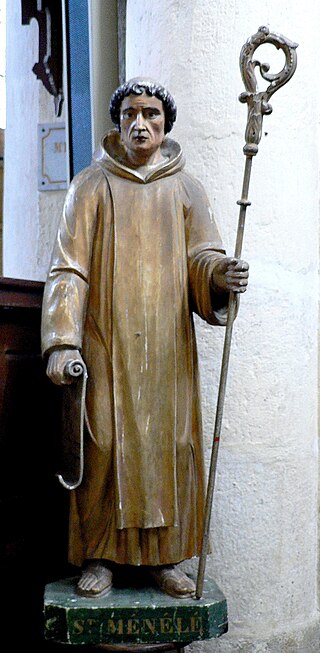Related Research Articles
Saint Adalbert may refer to:
Adalbert is a German given name which means "noble bright" or "noble shining", derived from the words adal and berht. Alternative spellings include Adelbart, Adelbert and Adalberto. Derivative names include Albert and Elbert.

Amandus, commonly called Saint Amand, was a bishop of Tongeren-Maastricht and one of the great Christian missionaries of Flanders. He is venerated as a saint, particularly in France and Belgium.
Saint Acarius was a monk of Luxeuil Abbey, who became bishop of Doornik and Noyon, which today are located on either side of the Franco-Belgian border.

Sigebert III was the Merovingian king of Austrasia from 633 to his death around 656. He was described as the first Merovingian roi fainéant —do-nothing king—, in effect the mayor of the palace ruling the kingdom throughout his reign. However he lived a pious Christian life and was later sanctified, being remembered as Saint Sigebert of Austrasia in the Roman Catholic Church and Eastern Orthodox Church.

Gertrude of Nivelles, OSB was a seventh-century abbess who, with her mother Itta, founded the Abbey of Nivelles, now in Belgium.
Saint Amatus, also called St. Aimé or Aimé of Sion, was a Benedictine monk.
Erchinoald succeeded Aega as the mayor of the palace of Neustria in 641 and succeeded Flaochad in Burgundy in 642 and remained such until his death in 658.
Jonas of Bobbio was a Columbanian monk and a major Latin monastic author of hagiography. His Life of Saint Columbanus is "one of the most influential works of early medieval hagiography."

February 1 - Eastern Orthodox liturgical calendar - February 3
Saint Vindicianus (Vindician) was a bishop of Cambrai-Arras. His feast day is 11 March. He is called a spiritual follower of Saint Eligius.
Rictrude was abbess of Marchiennes Abbey, in Flanders. The main early source for her life is the Vita Rictrudis, commissioned by the abbey, and written in 907 by Hucbald.

Maurontius of Douai was a nobleman and Benedictine abbot. His parents were Rictrude and Adalbard. He is a Catholic saint, with a feast day on May 5, especially venerated in Douai, France. His sisters Clotsinda, Adalsinda and Eusebia of Douai are also saints.

Anchin Abbey was a Benedictine monastery founded in 1079 in the commune of Pecquencourt in what is now the Nord department of France.

Saint-Amand Abbey, once known as Elno, Elnon or Elnone Abbey, is a former Benedictine abbey in Saint-Amand-les-Eaux, Nord, France.

Marchiennes Abbey was a French monastery located on the Scarpe in Marchiennes. It was founded around 630 by Adalbard of Douai, and Irish monks, disciples of Saint Columbanus, on the advice of Saint Amand. One of its founders was Rictrude, who made it double monastery in 643. In around 1024 it became monastery of men again and adopted the Benedictine rule. On the birth of the town of Marchiennes the abbey became its economic motor until being suppressed in 1791 during the French Revolution. In 1814 all but its 1748 gatehouse was demolished. Its remains were inscribed on the inventory of monuments historiques on 17 May 1974,
Adalsinda or Adalsindis of Hamay and Eusebia of Douai, were 7th-century Columban nuns, who were sisters from a prominent Merovingian family; Eusebia became an Abbess. They are venerated as saints in the Catholic and Eastern Orthodox Churches. Their parents were Richtrudis, a Gascoigne-Basque heiress, and Adalbard I of Ostrevent, a Frankish duke of Douai. Both mother and father are also recognised as saints, as are another sister, Clotsinda, and a brother, Maurontius. They are especially venerated in Northern France and Flanders.

Saint Geremarus was a Frankish monk and abbot. His feast day is 24 September.

Saint Meneleus was a French monk who founded the Menat Abbey.
Jonatus or Jonath was a Christian monk. He was a monk at the monastery of Elnone under Abbot Amandus. He served as the first abbot of the monastery of Marchiennes from 641, according to the Annals of Marchiennes. This monastery had been founded as a male community by Amandus, but Jonatus introduced nuns. This took place not long after he became abbot, according to the Chronicle of Marchiennes. The first nun was Rictrude.
References
- ↑ Monks of Ramsgate, Book of Saints, 1921: "Adalbald". CatholicSaints.Info. 30 April 2012
 This article incorporates text from this source, which is in the public domain .
This article incorporates text from this source, which is in the public domain . - ↑ Nominis: Saint Adalbade
- ↑ Forum orthodoxe.com: saints pour le 2 février du calendrier ecclésiastique
- 1 2 Alban Butler, Alban. "Saint Mauront, Abbot". Lives of the Fathers, Martyrs, and Principal Saints, 1866. CatholicSaints.Info. 4 May 2013
 This article incorporates text from this source, which is in the public domain .
This article incorporates text from this source, which is in the public domain . - ↑ Chaume, Maurice ' 'Les origines du Duche de Bourgogne' '. Darmstadt: Scientia Verlag Aalen, 1977, partie II,1 p. 264"
- ↑ Bush, Annie Forbes. Memoirs of the Queens of France, Parry & Macmillan, 1854, p. 58
 This article incorporates text from this source, which is in the public domain .
This article incorporates text from this source, which is in the public domain . - ↑ Ugé, Karine. "The Legend of Rictrude", Anglo-Norman Studies XXIII: Proceedings of the Battle Conference 2000, Boydell & Brewer, 2001, p. 294 ISBN 9780851158259
- ↑ "Sant 'Adalbaldo", Santi e Beati, November 1, 2008
- ↑ Van den Akker sj, Dries. "Adalbald of Douai", Heiligen, 2008
- ↑ He should not be confused with Saint Adalbert II of Ostrevent (died 790), father of Saint Renfroie de Danain .